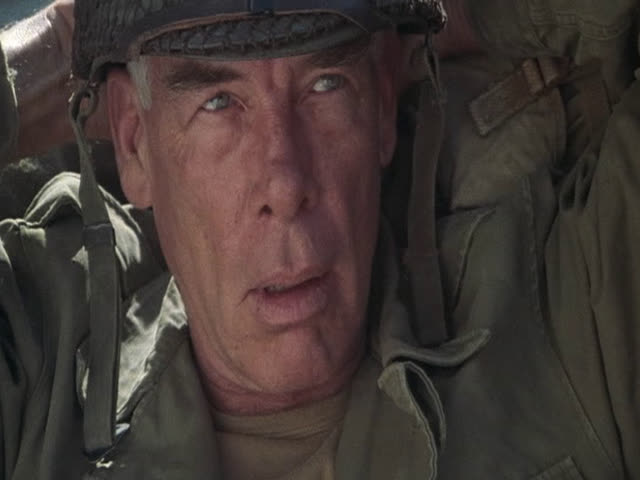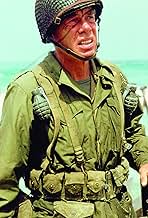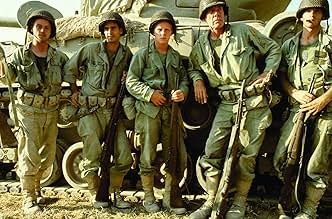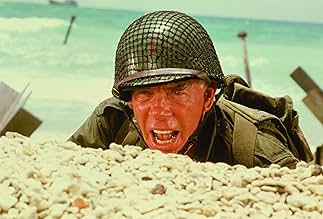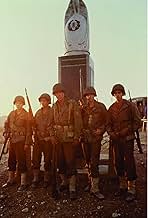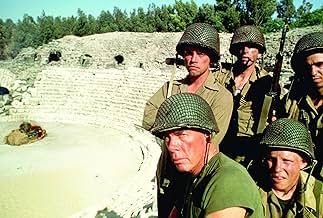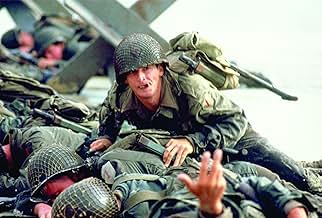Un sergente veterano e i quattro membri principali della sua unità di fanteria cercano di sopravvivere alla seconda guerra mondiale mentre si spostano di battaglia in battaglia attraverso l'... Leggi tuttoUn sergente veterano e i quattro membri principali della sua unità di fanteria cercano di sopravvivere alla seconda guerra mondiale mentre si spostano di battaglia in battaglia attraverso l'Europa.Un sergente veterano e i quattro membri principali della sua unità di fanteria cercano di sopravvivere alla seconda guerra mondiale mentre si spostano di battaglia in battaglia attraverso l'Europa.
- Regia
- Sceneggiatura
- Star
- Premi
- 2 vittorie e 2 candidature totali
- Underground Walloon Fighter at Asylum
- (as Stephane Audran)
Recensioni in evidenza
I cannot agree with these beliefs. The Big Red One is not only one of the greatest WWII films, it is also one of the greatest war movies.
Sam Fuller's film, which was butchered by the studio, is the picaresque tale of 5 members of the First Infantry, known, because of their shoulder patch, as the Big Red One. The film moves from one story to the next without spending too much time on any particular tale.
The individual vignettes, as they must, vary in quality, but on the whole are excellent. The Big Red One stirs within you a desire to run right out and tell your friends about this amazing scene or that.
There's the soldier who loses his testicle, the birthing scene in the belly of a tank, Lee Marvin, in Middle Eastern garb, traipsing across a beach, soldiers dug into holes over which a Panzer tank division travels, the entire Mad House segment... The list goes on.
Some people dislike the absurdest nature of several of this film's stories, but, for me, those surreal touches make this film great.
Without them (and there are a lot), you would be left with a very normal and very boring film. Using bandoleers as stirrups is genius, as is the woman faking crazy as she whirls through a monastery, slicing German throats.
The performances are solid, for this type of film, but if you are looking for subtlety, go elsewhere. Each character is drawn in broad strokes; you never learn too much about them, but you learn enough to understand who they are and why. Lee Marvin, as usual, is amazing. He is one of the great, gruff actors of our time, bringing a special, intangible quality to every film in which I've seen him. He makes every movie he's in better just by showing up. There are too few actors about whom you can say that.
Like the acting, the direction is masculine, but, for a war movie, that's a compliment. In some ways, Fuller's direction here and in his other films reminds me of Hemmingway's writing - terse and effective. Both men believe in an economy of shots or words, depending on their medium, but, through that economy, they attain a muscular sort of poetry akin to the beauty of a horse's rippling muscles as it races on a plain. Fuller's direction here, though not his best when compared to Underworld USA or Shock Corridor, is still better than most, especially considering that this was his first film in several years.
All in all, I find the Big Red One to be an exemplary war movie, even in its emasculated format (I cannot wait to see the restored, 140 minute print, which should improve upon scenes that feel to brief in this version). It's certainly no Apocalypse Now, but it puts to shame most World War II epics before or since.
It is basically a movie that follows one platoon as they go through the war, and how each individual soldier wrestles with various demons so to speak. There is enough action to keep things moving.
Would recommend to anyone who likes, war movies, actions movies or seeing Luke Skywalker as a young soldier.
Lee Marvin, an actual WWII veteran himself, holds the film together as the tough but exhausted seargent. When he tells Mark Hamill (yes, Luke Skywalker, folks) that you don't murder animals, you kill them, the look on his face after that seems to say that he wished it could be some other way. It's hard to grab defining moments in this film as stand-out, but the two sequences that stick the most to my mind are the taking of the insane asylum and the horrors of the concentration camp. While other movies have focused on specific campaigns, "The Big Red One" deserves high marks for painting the broad canvass of the Second World War from the perspective of the guys who actually had to do the work.
This is not a bad thing, as you can tell from the enthusiastic reception Fuller's movies have gotten here on IMDB. But "The Big Red One" is also drastically cut down from the original print Fuller had, and I wonder if that's why it feels so disjointed.
Of course, it is supposed to be episodic, but I don't know. I didn't really get into it.
Lo sapevi?
- QuizThe bulk of the picture was shot in Israel, and director Samuel Fuller remarked that it was unsettling after a scene was shot when the German soldiers and SS troops would take off their helmets and Fuller would see them wearing yarmulkes; also, between takes they would be sitting around the set in full Nazi uniform speaking Hebrew or reading the Torah.
- BlooperDuring the WW1 scene between the Sergeant and the officer in the dug-out, the Sergeant learns that the armistice had been signed 4 hours previously at 1100hrs, November 11, 1918. While talking with the officer, the sergeant is cutting a piece of red cloth in the shape of a number '1' which he says he will submit as a proposed insignia for the division. However the shoulder sleeve insignia for the 1st Division consisting of a red number "1" was already approved on 31 Oct 1918.
- Citazioni
[the troop stops before a memorial]
Johnson: Would you look at how fast they put the names of all our guys who got killed?
The Sergeant: That's a World War One memorial.
Johnson: But the name's are the same.
The Sergeant: They always are.
- Versioni alternativeIn 2004, film critic Richard Schickel restored this film to a new director's cut length of approximately 160 minutes. Using Samuel Fuller's production notes and the full-length, unexpurgated script, Schickel restored the footage that was forced to be cut by the studio upon its original 1980 release (which runs 116 minutes). The restored version's DVD release date is 3 May 2005. This longer, epic-length version is closer to Fuller's original vision for the film.
- ConnessioniFeatured in A tout coeur: Episodio datato 7 maggio 1984 (1984)
- Colonne sonoreHorst-Wessel-Lied
Written by Horst Wessel
I più visti
Dettagli
- Data di uscita
- Paese di origine
- Lingue
- Celebre anche come
- Más allá de la gloria
- Luoghi delle riprese
- Aziende produttrici
- Vedi altri crediti dell’azienda su IMDbPro
Botteghino
- Budget
- 4.500.000 USD (previsto)
- Lordo Stati Uniti e Canada
- 7.206.220 USD
- Lordo in tutto il mondo
- 7.206.823 USD
- Tempo di esecuzione1 ora 53 minuti
- Colore
- Mix di suoni
- Dolby Stereo(original release)
- Proporzioni
- 1.85 : 1
Contribuisci a questa pagina


